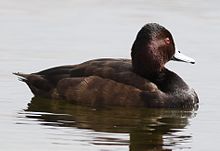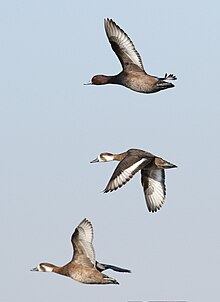Roach duck
| Roach duck | ||||||||||||
|---|---|---|---|---|---|---|---|---|---|---|---|---|

Roach duck, female ( Netta erythrophthalma ) |
||||||||||||
| Systematics | ||||||||||||
|
||||||||||||
| Scientific name | ||||||||||||
| Netta erythrophthalma | ||||||||||||
| ( Wied , 1832) |
The roach duck ( Netta erythrophthalma ) is a diving duck from the goose family that is widespread in South America and Africa . Two subspecies are distinguished from it: Netta erythrophthalma erythrophthalma is the nominate form that occurs in South America, N. e. brunnea is the African subspecies. There is only a slight difference in plumage between the two subspecies. The population of this duck has been declining in South America for several years. In contrast, the population in Africa is stable.
The roach duck was first scientifically described by Prince Maximilian zu Wied-Neuwied in 1832 after his first South American expedition.
Appearance
The roach duck reaches a body length of 48 to 51 centimeters. In flight it is noticeable that the wings are set relatively far back on the body.
Roach ducks have a pronounced sexual dimorphism . In the magnificent dress the male has a black-violet head and neck. The chest is also shiny black, while the rest of the body is almost uniformly dark brown or mahogany in color. The back plumage is more olive brown. The rear belly and the lower tail cover are rust-brown. The tail feathers, on the other hand, are dark brown and there is a white mirror on the upper side of the wing. The beak is blue-gray with a black nail. The legs and feet are blue-gray to black.
The female is predominantly red-brown in color. Their back plumage is also significantly darker, while the flanks are more red-brown. The face is white at the base of the beak. The white color extends towards the eye in a crescent shape. A broad brown band runs from the end of the ridge of the beak to the top. The iris is brown. The beak is slate gray.
Fledglings are similar to adult females. With them, however, the white facial markings are less noticeable. The chicks are light olive brown on the headstock at the back of the neck and on the back. The forehead, throat and face are pale straw yellow. There is a narrow, olive-brown ear strip on the face.
Distribution and existence
The roach duck occurs in Africa mainly in the south and east. Breeding occurrences north of central Kenya and western Uganda are not known. As a migratory bird it occurs in Ethiopia as far as Eritrea . Occasionally she is seen as a stray visitor in Somalia. Population figures for this species have not yet been reliably determined. However, the population number is estimated to be 30,000 to 70,000 individuals. In the dry season, roach ducks that breed in southern Africa migrate to Zimbabwe, Zambia, Malawi, Botswana, Mozambique and Kenya. Their altitude distribution in Africa ranges from the lowlands of the coastal region to heights of 2,400 meters above sea level.
In South America their range is now disjoint. It occurs in the north and west of Venezuela, in Peru, in the north-west of Argentina and in eastern and central Brazil. Its distribution area originally also included the north of Chile as well as Ecuador and Trinidad. In Peru it occurs in two nature reserves and is on the Peruvian Red List. In Venezuela, the population is estimated at 5,000 to 10,000 individuals. Overall, it is assumed that there are still around 2,500 individuals in western South America, while the population in eastern South America is between 10,000 and 25,000 individuals. Their height distribution ranges from the lowlands of the coastal region up to 3,400 meters above sea level. Seasonal train movements also occur in South America. However, they have not yet been adequately investigated.
habitat
Roach ducks need freshwater bodies of water with rich underwater vegetation as their habitat. It does not seem to make any further demands on its living space. It colonizes bodies of water of different sizes and depths. It also populates bodies of water that only exist temporarily. In Brazil, the roach duck has expanded its range and uses water retention basins that were built on the central plateau. In Venezuela it is also found in rice fields.
Food and foraging
Roach ducks are diurnal ducks that look for their food mainly during the day. It is most active in the early morning and evening. She spends most of the time in between resting on the shoreline or on the water. She looks for her food mainly by diving. However, it also digs for food or sifts the surface of the water.
The roach duck feeds almost entirely on plants. However, aquatic organisms are ingested with the vegetable diet. It mainly eats the seeds of aquatic plants and to a small extent also green parts of the plants. Rice is also one of their food crops.
Reproduction
Roach ducks breed all year round. However, the number of clutches increases during the rainy season. Since the drakes show only a restrained courtship repertoire and the pairs are mostly in the outer edge area of the reeds, the breeding business is inconspicuous. The nest has a diameter of 17.5 to 28 centimeters and is 10 to 23 centimeters deep. It is built from plant material and covered with dunes. It is usually found in the tall vegetation in the bank area.
The eggs are creamy white to light brown. The female breeds alone. The breeding season is between 23 and 26 days. In the process, the pair bond between males and females loosens. As a rule, the male leaves the breeding female and retreats to the moulting area. Occasionally, however, the males stay with the female when she is leading the chicks. The chicks can fledge after seven to eight weeks. They reach sexual maturity in the first year of life.
Attitude in Europe
The first European owner of this species of duck was the London Zoo in 1851. A French zoo also kept this species of duck from 1925 to 1940. However, the efforts to breed were unsuccessful. The world first breed was achieved by the British Wildfowl Trust in 1951 with the African and 1961 with the South American subspecies. In the case of the enclosure animals kept in Europe today, however, an assignment to the subspecies is no longer possible.
supporting documents
Individual evidence
- ↑ Kolbe, p. 267
- ↑ Kear, p. 636
- ↑ Kear, p. 636
- ^ Kear, p. 637
- ^ Kear, p. 637
- ^ Kear, p. 637
- ^ Kear, p. 638
- ↑ Kolbe, p. 267
- ^ Kear, p. 638
- ^ Kolbe, p. 267 and p. 268
literature
- Janet Kear (Ed.): Ducks, Geese and Swans. Oxford University Press, 2005, ISBN 0-19-854645-9 .
- Hartmut Kolbe: The world's ducks. Ulmer Verlag, 1999, ISBN 3-8001-7442-1 .
Web links
- Netta erythrophthalma inthe IUCN 2013 Red List of Threatened Species . Listed by: BirdLife International, 2012. Retrieved February 6, 2014.


